Journal of the NACAA
ISSN 2158-9429
Volume 12, Issue 2 - December, 2019
Development of a UAS-based Insect Scouting Method
- Neufeld, J , Extension Educator, University Of Idaho
Ryu, J, Associate Professor, University of Idaho
Barbour, J, Extension Professor, Emeritus, University of Idaho
ABSTRACT
Unmanned Aerial Systems (UAS, also known as drones) are widely used for many civil operations, including emergency response, hazard monitoring, delivery service, and public safety. The agricultural drone market also has immense potential due to recent technology advancements in smartphone and other sensing devices. To date, most drone applications in agriculture focus on weed detection using cameras, and moisture stress using Normalized Difference Vegetation Index (NDVI) sensors. Little, or no research exists exploring drone-driven insect sampling in the field. The objective of this research project is to advance insect scouting using sweep net equipped drones and compare it with the standard sweep net method. The results are quite promising in the sense that sweep net equipped drones will be a potential way for insect scouting in extension communities in the near future.
INTRODUCTION
Lygus bugs, primarily Lygus hesperus, are the most damaging insects of alfalfa seed in western farmlands. They survive winter as adults in plant litter, headlands, uncultivated land, and become active and emerge from overwintering sites in southwestern Idaho in late March to early April each year. Lygus bugs prefer to feed on reproductive plant parts (flowers and seeds) by puncturing plant tissues with their needle-like mouthparts (stylets) and injecting salivary fluids that aid in the digestion of plant cellular material. Feeding on developing flowers causes stunting and blasting of flower buds which results in flowers failing to develop. Feeding on alfalfa seeds causes the seeds to shrink and lose quality and viability. All instars of lygus bugs can cause damage, but the late instars (fourth and fifth) and adults cause the most damage. Unchecked lygus bug feeding can result in seed losses ranging from 50 to 90 percent (O'neal, 2017).
Currently the standard scouting method for lygus is to use a 15 inch diameter sweep net to take five, 180-degree sweeps in four to five different areas of the field to evaluate lygus bug populations with respect to established action/economic thresholds (Figure 1). In pre-bloom alfalfa seed the threshold is four to six lygus per sweep, in blooming alfalfa seed the threshold is six to eight per sweep, and in post bloom alfalfa seed the threshold is 12 or more per sweep (O'neal, 2017). Because of time and cost constraints, insect scouts tend to sweep near edges of fields. Using sweep net-equipped UAS to scout fields may reduce the time needed to scout fields while also permitting easier scouting into more distant areas of large fields.
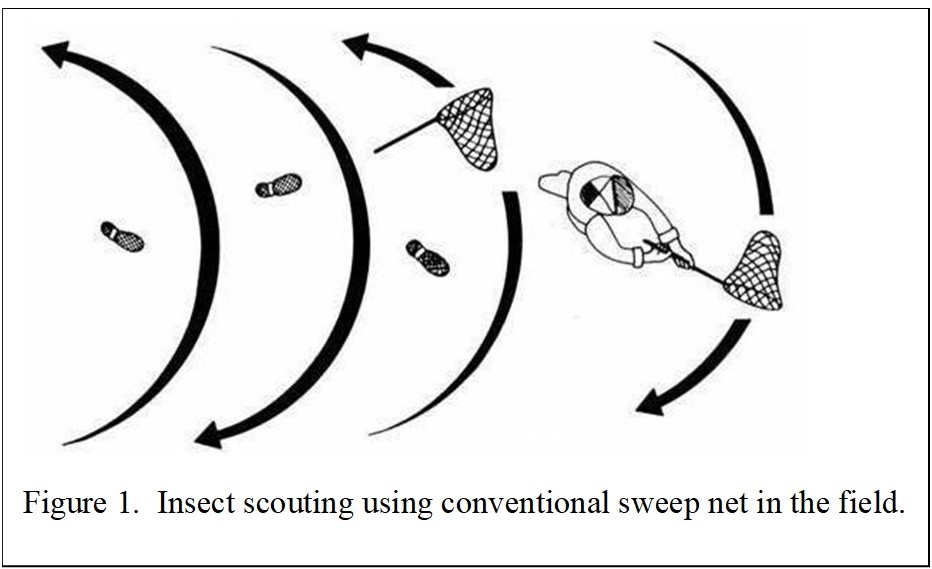
The increase in application of UAS technology has been spurred by recent advancements in smartphone technology, and the variety of sensors and devices that can be attached to drones. There are numerous UAS applications, including civil operations (Shakhatrech et al., 2018), emergency response (Restas, 2015), hazard monitoring (Giordan et al., 2017), delivery service (Jung, 2017), and public safety (Mozaffari et al., 2018). The agriculture UAS market, has great potential for numerous applications. According to the new market research report, the agriculture UAS market is expected to grow to $4,210 million in 2022 (Markets, 2018). Most current UAS applications in agriculture, include weed detection, plant counting, and crop health monitoring using a suite of sensors (e.g., multispectral sensors, thermal cameras, and GPS), but little, if any, research exists in the agricultural engineering and extension literacy disciplines on UAS-driven insect sampling. Therefore, with the urging of the Idaho Alfalfa and Clover Seed Growers Commission, our research team began developing an innovative UAS-based insect scouting method.
METHODS
Although the Idaho Alfalfa and Clover Seed Growers Commission is interested in how UASs can be used in alfalfa seed production, they indicated that some growers are already using drones for agricultural applications, and they did not want us to duplicate what commercial industry is already doing; photography, and thermal imaging as detailed above. They were, however, interested in investigating new ways in which drones could be used in alfalfa seed production, including insect sampling and scouting. We are not aware of anyone using drones as a tool to assist in insect scouting in alfalfa seed fields for lygus bugs, or for other insects in other crops.
Two rotary drones, a DJI Phantom 4 Professional (P4P) and Matrice 600 (M600) manufactured by DJI are being used for this applied research project. Rotary drones can fly in every direction, horizontally and vertically, as well as hovering in a fixed position at the starting point for scouting. Flying orientation, at low elevation is critical to capturing lygus bugs over alfalfa seed fields. Figure 2 shows the two different UAS configurations and their key specifications and performance ranges for this research.
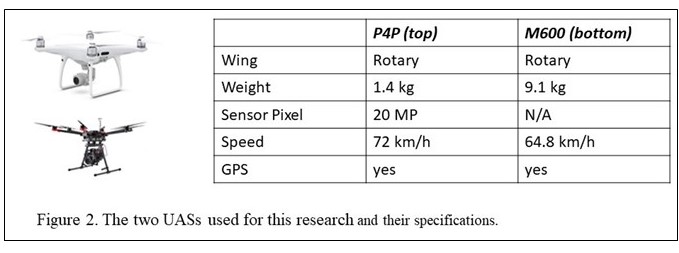
Late in the summer of 2016, we conducted preliminary scouting work with a P4P drone. We were able to collect a few lygus bugs in alfalfa seed and were encouraged enough to continue this work in the summer of 2017. At that time, we evaluated our ability to capture lygus bugs using several drone-attached devices. We first suspended a short length of two-inch diameter PVC pipe sprayed with Tanglefoot® Tangle-Trap Sticky Coating Spray about five feet below the P4P and then flew the drone to various locations in the field dragging the PVC pipe through the alfalfa seed canopy. We then repeated this procedure, replacing the PVC pipe with a funnel sprayed with the same sticky coating. Again, we were able to collect a few lygus bug using either procedure, but needed to increase the number of lygus bugs captured to develop a viable sampling technique. Late in the 2017 growing season, we suspended a 12 inch diameter sweep net from the P4P and were able to capture lygus bugs in good numbers when the net was dragged through the alfalfa seed canopy (Figure 3). Analysis of the 2017 data indicated a significant, positive correlation (r=0.42) between the number of lygus bugs captured using the standard sweep (five sweeps using a 15 inch diameter net) and the 12 inch diameter sweep net suspended and dragged by the drone. We felt this showed enough promise to continue this work.
For the 2018 and 2019 growing seasons, we conducted 8 consecutive weeks of scouting in each of three grower fields (replicates), with three sampling methods (treatments): 1) 12 inch diameter net modified and suspended from the P4P drone, 2) 15 inch net modified and suspended from the M600 drone, 3) standard five-sweep sample collected manually using 15 inch diameter net. The three sampling methods were repeated at 4 randomly assigned locations (subsamples) in each field. We did not start scouting until the temperature was at least 70 degrees Fahrenheit to ensure that lygus bugs were active. Each drone was flown manually with the net suspended in the top half of the alfalfa seed canopy for 100 feet from one edge of the treatment field towards the middle of the field. Standard sweeps were conducted about 75 feet from the field edge.
During sampling, the opening of the sweep net was facing the direction of travel with the top of the net tilted slightly forward (ahead of the bottom of the net). The flight altitude was approximately 15 feet above the ground and UAS speed was 5 miles per hour with the sweep net positioned to groom approximately the top 10 inches of the alfalfa seed canopy. After several test flights the UAS Pilot in Command had very little trouble accomplishing this task. The flight mission is accomplished by FAA-certified pilots and all flight records are transmitted to the pilot in real time via mobile devices, such as smartphones.
For the most part, the modified sweep nets we devised worked well. The 12 inch diameter net was made from an off the shelf embroidery hoop. The net component we used was sewn from muslin fabric. The 15 inch net was simply a conventional sweep net with the handle removed. The nets were attached to the drones with various hardware fittings and wire. Sweeps conducted earlier in the growing season seemed to work the best from the standpoint of moving the net through the alfalfa canopy. It was sometimes difficult to orient the net so that it was open in the direction of travel. During the latter part of the growing season when the alfalfa plants were drier and the stems were tougher, the net occasionally would catch in the alfalfa causing the drone to crash. Wire and hardware improvements in the connections between the drone and the net, and in the net itself would improve net movement through the crop canopy. In addition, software improvements would allow more precise control of drone altitude, speed, and flight distance to reduce variability in the trap catch between drones and pilots. As we move forward with this project these issues will need to be addressed through better design and engineering.
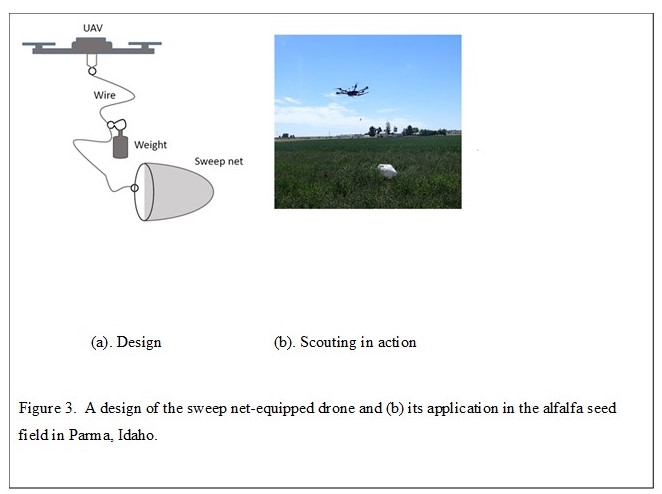
Statistical Analysis
The data were analyzed using a randomized complete block design (RCB; Shieh and Jan, 2004) with three replications (fields) to determine the strength of the correlation between the number of lygus bugs captured using drones vs. the standard sweep net sampling. The four subsamples of each treatment in each field were pooled to reduce variation. We also calculated the coefficient of variation (CV) to indicate the degree of dispersion of the sampling means for the three sampling methods. Figure 4 illustrates a schematic of randomized complete block design.
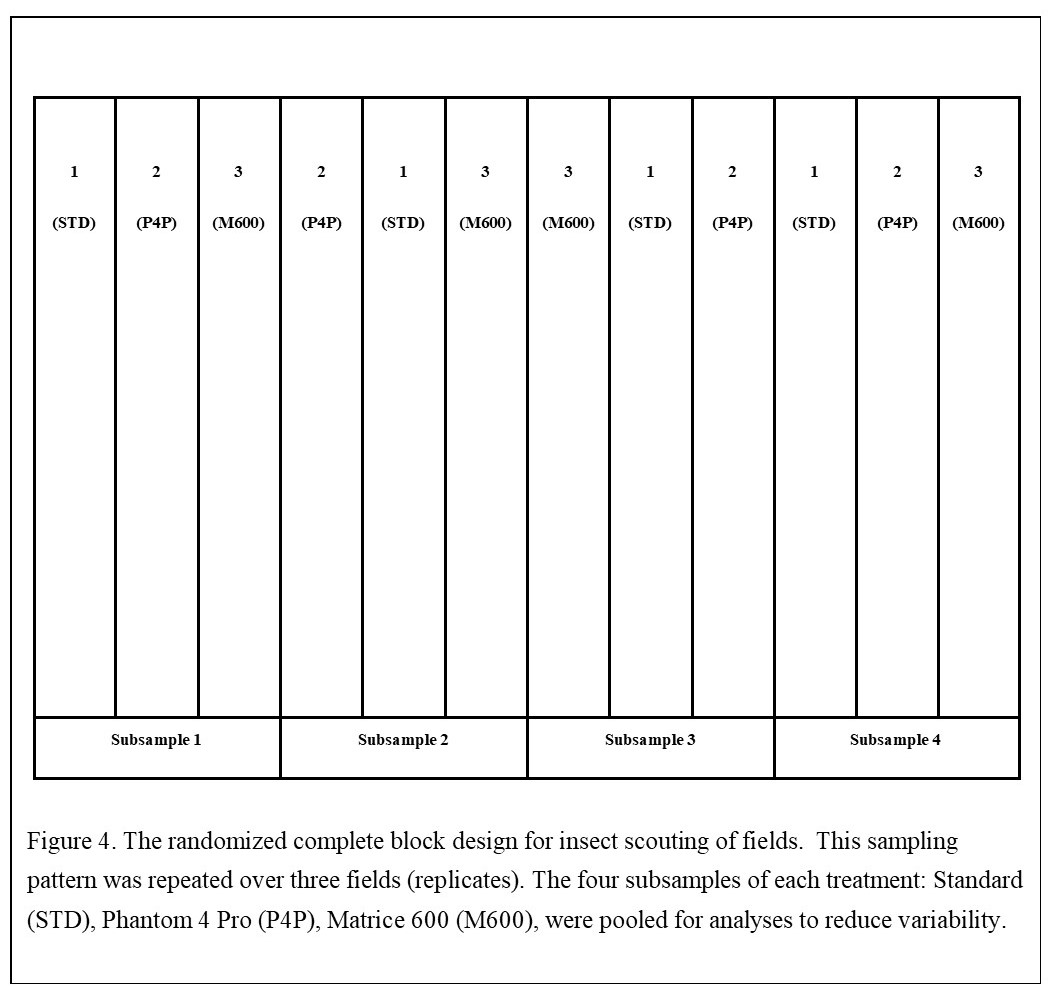
RESULTS
Based on our 2018 and 2019 research, the positive correlation coefficients between the P4P and M600 versus the standard sweep net for capturing lygus nymphs are highly encouraging (Table 1). The number of lygus bugs captured was generally higher in the standard sweep samples. However, both M600 and P4P performed quite well in capturing lygus nymphs using the modified sweep nets, though correlations from M600 samples are slightly stronger. These data indicate that when the conventional sweep net captured more lygus nymphs, so did the UASs; and when the conventional sweep net captured fewer lygus nymphs, so did the UASs, indicating that lygus economic thresholds based on standard sweep samples may be predicted from drone samples. Coefficients of Variation for the lygus sampling variables indicate moderate dispersion of data, with standard variations about 1.5 to 2.0 times the mean, except for total lygus where standard deviations tended to be equal to or lower than the mean for all sampling methods (Table 2). These results are quite promising and we plan to continue our efforts on this project for one more growing season.

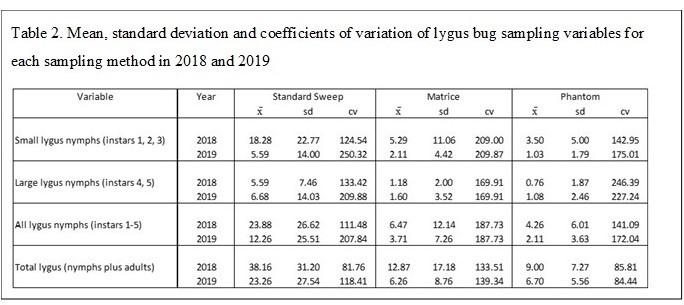
CONCLUSIONS
With this project, the team was able to make the case that lygus in alfalfa seed represent a great test system to develop a UAS-based insect scouting method using a sweep net. We believe this scouting approach will be scalable and transferable to other economically important crops, such as canola, soybeans, cotton and others where considerable resources are spent on insect scouting to manage pests. Over the past few years the authors have continually interacted with local growers and industry regarding potential UAS use for lygus bug sampling to investigate how UAS-based scouting method could be used to assist in scouting alfalfa seed fields. Based on the input collected and our experimental results, we are refining and reshaping this research project. In the future we would like to investigate as to whether a hyperspectral sensor could be used to identify lygus damage, which could do away with the sweep net altogether. In the shorter term we would like to add the feature of being able to pre-program lygus scouting flights which would reduce variability and increase the usefulness of this scouting method.
ACKNOWLEDGMENTS
This project is primarily supported by College of Agriculture and Life Sciences (CALS) at the University of Idaho (UI) through Innovative Projects program and partial funding support for Dr. Jae Hyeon Ryu is also made from the President’s Office at UI via “Vandal Idea Project (VIP)” grant named “Idaho Drone League (iDrone)”.
REFERENCES
DJI. (2018). "Phantom 4-Visionary intelligence and elevated imagination, available at https://www.dji.com/phantom-4, accessed October 20, 2018."
Giordan, D., Manconi, A., Remondino, F., and Nex, F. (2017). "Use of unmanned aerial vehicles in monitoring application and management of natural hazards." Geomatics, Natural Hazards and Risk, 8(1), 1-4.
Jung, S. (2017). "Analysis of Amazon Prime Air UAS Delivery Service." Journal of Knowledge Information Technology and Systems, 12(2).
Markets, M.A. (2018). "Agricultural Drones Market by Type, Application, Component and Geography-Global Forecast to 2020." Available at https://www.marketsandmarkets.com/Market-Reports/agriculture-drones-market-23709764.html (accessed September 30, 2018).
Mozaffari, M., Saad, W., Bennis, M., Nam, Y.-H., and Debbah, M. (2018). "A Tutorial on UASs for Wireless Networks: Applications, Challenges, and Open Problems." Available online at https://arxiv.org/pdf/1803.00680.pdf (Accessed October 24, 2018).
O'neal, S. (2017). "Pest Management Strategic Plan – with a Special Focus on Pollinator Protection – for Alfalfa Seed Production in the Western United States." Available online at https://ipmdata.ipmcenters.org/documents/pmsps/AlfalfaSeedPMSP_FINAL.pdf.
Restas, A. (2015). "Drone Applications for Supporting Disaster Management." World Journal of Engineering and Technology, 3(January), 316-321.
Shakhatrech, H., Sawalmeh, A., Al-Fuqha, A., Dou, Z., Almaita, E., Khalil, I., Othman, N. S., Khreishah, A., and CGuizani, M. (2018). "Unmanned Aerial Vehicles: A Survey on Civil Applications and Key Research Challenges, Available online at https://arxiv.org/abs/1805.00881."
Shieh, G., and Jan, S.L. (2004). "The effectiveness of randomized complete block design." Statistica Neerlandica, 58(1), 111-124.
